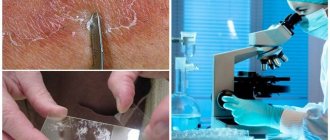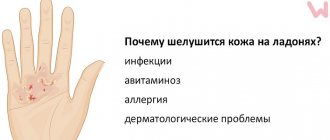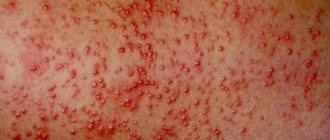Causes of penis allergies
Basically, the localization of foci of allergic inflammation only on the penis indicates one of two diseases:
- Fixed erythema.
Appears mainly as an allergic reaction to the use of medications.
Main reasons:
- tetracyclines
- sulfonamides
- antiepileptic drugs, in particular carbamazepine
Severe manifestations of allergies in the form of pustules (ulcers) develop when using halogen derivatives.
However, at present they practically do not occur due to the extremely rare use of this group of drugs.
- Allergic dermatitis.
Develops when the skin of the penis comes into direct contact with an allergen.
Probable reasons:
- lubricant – applied to the penis before sexual intercourse
- spermicides – used for contraception and reducing the risk of contracting sexually transmitted infections
- condom – contains latex, to which a man may be allergic
- topical preparations - applied to the penis to treat any diseases (usually when a rash appears, mechanical damage to the skin)
- antiseptics – used after sexual intercourse to reduce the risk of transmitting STDs
- hygiene products – sometimes a man uses separate products for genital hygiene
- underwear – may contain dyes; some men experience allergic reactions to the fabric
If you are allergic to a condom, the cause is not always latex.
Contraceptives often contain substances that are intended to have a specific effect on the characteristics of sexual intercourse.
Most often these are irritants or local anesthetics (to reduce the sensitivity of the penis and prolong sexual intercourse).
Anesthetics are among the most common causes of drug allergies.
If allergies on the head of the penis appear after sex, the cause may be the substances used by the woman.
These are cosmetics, vaginal tablets or suppositories.
During sexual intercourse, their vaginas end up on the penis.
After a few minutes, hours, and sometimes days, manifestations of an allergic reaction occur.
According to one German study, the most common causes of local allergic reactions in the anogenital area are:
- local medications – 61% of cases
- cosmetics – 42%
- intimate hygiene products – 14%
- condoms – 6%
- clothing – 4.5%
As you may have noticed, the percentage here is much more than one hundred.
And this despite the fact that not all possible allergens are listed.
The fact is that in many patients, skin tests reveal 2 or more substances that can provoke manifestations of allergic contact dermatitis on the penis.
Why might the penis be itchy?
Interested in the question: “Why does the penis itch?” - we answer. The causes of itching of the genitals can easily be external irritants - hypothermia and overheating of the penis or scrotum, chemicals and synthetic underwear.
In some cases, symptoms may result from exposure to potent topical medications.
Sometimes itching appears due to disturbances in the functioning of internal organs. For example, as a result of blood diseases (anemia, leukemia, lymphogranulomatosis) or as hepatitis, kidney disease, endocrine system disorders, cancer.
A situation where very severe itching of the head of the penis is accompanied by external changes may be the result of an allergy.
Why was there no penis allergy before and suddenly appeared?
Some men are perplexed when they are found to be allergic to a certain substance.
They cannot believe that it was this hygiene product, drug or condom that caused the allergic reaction.
Because the man used the same thing before, but there were no symptoms!
What is this connected with?
There are only two options:
- What you used before did not contain the allergen.
For example, you always bought a regular condom, but then switched to contraceptives containing local anesthetics (to prolong sexual intercourse).
Or a new component has been added to your usual hygiene product.
That is, before there were no allergy symptoms on the head of the penis, because you did not come into contact with a substance that could cause such a reaction.
- Sensitization has occurred.
An allergic reaction never develops after the first contact with an allergen.
Because your immune system is not yet familiar with this substance.
Accordingly, he cannot react to it.
But then time passes, antibodies are produced, and now every contact with an allergen is accompanied by a violent reaction.
Sensitization is the name given to the process of acquiring increased sensitivity of the body to a certain substance.
It can last from several days to several years.
How long sensitization will last depends on how strong the allergen affects the skin of the penis.
If it is strong, then hypersensitivity reactions will begin to develop within a few days after contact with a substance to which there is an individual intolerance.
In this case, the symptoms will be more pronounced.
If a man says that there was no allergy to this substance before, although it was used regularly, and now local symptoms appear, most likely it is a weak allergen.
Sensitization can last for months or even years.
During this period, the man uses the substance safely without fear of developing symptoms.
But when the period of sensitization ends, clinical manifestations of a hypersensitivity reaction appear.
From this moment on, every contact is accompanied by rashes.
As a rule, if sensitization lasts a long time, this means that the allergen is weak.
Therefore, it causes mild symptoms, and they may appear with a delay.
When exposed to a weak allergen, chronic allergies or chronic allergic dermatitis often develop.
It is associated with prolonged exposure to a substance to which the patient has a hypersensitivity reaction.
The symptoms are mild and do not appear immediately, so the patient does not understand what he is allergic to.
He continues applying the same product to the penis.
As a result, dermatitis becomes protracted.
Special symptoms appear that are not characteristic of acute or subacute allergic dermatitis.
general information
Hypersensitivity of the head of the penis is one of the most common causes of premature ejaculation.
Associated with local changes in the penile area. Early ejaculation caused by psychogenic disorders, prostatitis, neurological diseases, and the use of certain medications should be distinguished from this condition. The cause of primary hypersensitivity is excessive innervation of the glans due to an increase in the number of nerve endings that transmit signals to the dorsal nerves of the penis. This variant is observed from birth, persists throughout life, and is not associated with other diseases. In other cases, increased sensitivity occurs against the background of local irritating influences or a temporary change in the psychological state, causing an enhanced reaction to various stimuli.
Penis allergy symptoms
Allergic dermatitis can occur in various forms:
- acute
- subacute
- chronic
With acute allergies, redness appears.
It goes beyond the zone of influence of the allergen.
Papules form on hyperemic skin.
They turn into bubbles that quickly open.
In the subacute form of allergies, the doctor often finds plaques covered with scales.
Chronic allergy on the penis is characterized by the occurrence of foci of lichenification.
This is a thickening of the epidermis.
The skin pattern on it is enhanced.
Due to itching, the patient scratches the problem area, excoriation (scratching) occurs.
Over time, hyperpigmentation appears.
There is no redness or it is mild.
Small papules may appear on the surface of the skin.
Diagnosis of itching of the penis
Some symptoms of itching may go away on their own, without the need to visit a doctor. For example, itching due to ingrown hairs goes away within 7 days, or itching, inflammation and redness from contact dermatitis can be eliminated with hygiene and changing the type of underwear (to cotton and loose ones). But there are also diseases that will only get worse without drug intervention.
The doctor can determine the cause of the disease during the initial examination. If necessary, the following may be prescribed: smears from the male genital organ, scrapings of peelings, blood and urine tests, ultrasound of the pelvic organs. In each individual case, a specific type of diagnosis is prescribed.
How to determine an allergy to the penis?
Initially, the doctor examines the patient.
He may suspect an allergic reaction based on characteristic symptoms and medical history.
Sometimes the patient himself notices that manifestations occur after contact with a certain substance.
In this case, the doctor’s task is to distinguish the direct toxic effect of the substance used from an allergic reaction.
The main signs of how allergies differ from other diseases of the penis:
- Localization.
The rashes are localized only on the area of the skin that was exposed to the allergen, and protrude somewhat beyond its limits.
This is most clearly seen in the case of an allergic reaction to a condom.
Then the area of redness with elements of the rash follows its contours.
The situation is similar with other allergens.
The rash appears only where the ointment was applied, the penis came into contact with underwear, etc.
There are no rashes in other areas.
Over time, it does not spread to the periphery.
- The phenomenon of increase.
This is a sign that allows you to distinguish allergic dermatitis from simple contact dermatitis.
That is, from a disease in which the skin reaction is not caused by an allergy, but by the toxic effects of a chemical compound.
The symptoms may be quite similar.
However, with simple contact dermatitis, a fading phenomenon is observed.
The skin reaction is maximum after contact with the substance that causes the rash.
After these contacts cease, it gradually decreases.
With allergic dermatitis on the penis, the situation is the opposite.
Initially, there may be no symptoms at all.
Then they appear some time after contact with the allergen.
Even if this contact is stopped, symptoms continue to increase for some time.
- Papules.
With toxic damage to the skin of the penis, papules usually do not appear.
First, an area of redness forms.
Bubbles form on it, which then turn into crusts and gradually heal.
With allergies, many papules are formed.
If bubbles appear on the penis due to an allergy, this occurs at the next stage of the development of the disease.
Laboratory diagnosis of penis allergies
Patients with suspected allergies are tested.
They allow you to confirm the fact of allergic origin of inflammation of the skin of the penis.
IgE (immunoglobulin E) is usually determined in the blood using ELISA.
A cell stimulation test with allergens is performed.
It is possible to determine complement C3 and C4 in the blood.
Some patients are prescribed laboratory tests for mediators of allergic inflammation:
- histamine
- tryptase
- leukotrienes
The second stage of diagnosis begins after relief of the main symptoms.
The person is taken off antiallergic drugs: glucocorticoids, histamine blockers.
Beta blockers are not used.
Skin tests are performed to determine the allergen.
Any substance that can cause inflammation of the skin of the penis, a similar inflammatory process can initiate in any other parts of the body.
Standard tests to identify allergens:
- prick test
- intradermal test
- patch test
- scarification tests
The methods are essentially the same.
They differ only in the way the allergen is introduced into the skin.
The most sensitive is the intradermal test.
It allows you to identify even weak allergens.
The test involves injecting a substance into the skin with a tuberculin syringe.
A reaction is considered positive when a blister with a diameter of more than 3 mm forms at the injection site.
Late reactions to allergens are possible.
In this case, redness and thickening of the skin and the formation of blisters on it are observed only a few days after the injection.
Diagnostics
Establishing the causes of hypersensitivity is the responsibility of a urologist-andrologist. If an STI or allergic dermatitis is suspected, a dermatologist-venereologist or allergist is involved in the examination. During the interview, the doctor finds out when the symptom first appeared, whether its appearance was preceded by any diagnosed diseases or unusual changes in the head.
During an external examination, the mobility of the prepuce is assessed, signs indicating the possible nature of the disorder are identified: swelling, hyperemia, cracks, blisters, the presence of pathological discharge, enlargement of regional lymph nodes. In the absence of external changes to differentiate hypersensitivity and other causes of erectile dysfunction, the patient is offered a lidocaine test.
The essence of the manipulation is to apply 10% lidocaine to the head of the penis 10-15 minutes before sexual intercourse. You should have sex with a condom. If, according to the results of 3-5 tests, the duration of the act has significantly increased, this indicates hypersensitivity. If pathological symptoms are detected, laboratory tests are prescribed.
The basic examination is smear microscopy. If a large number of bacteria and leukocytes are detected, ELISA or PCR is performed to exclude specific infections, microbiological analysis to determine the nature of the microflora and sensitivity to antibiotics. Tests are prescribed for syphilis and HIV infection. For dermatitis, allergy tests are performed and the level of immunoglobulins is assessed.
Urological examination
Treatment of allergies to the penis
Treatment should begin with non-drug methods.
The main one is allergen elimination.
The first step is to stop contact with the substance causing the reaction, if it is known.
If this substance is not known, you should stop using any ointments, medications, contraceptives, change your underwear, etc.
That is, protect the skin of the penis from anything that could potentially cause allergies.
Pharmacotherapy is used to suppress symptoms.
The main antiallergic drugs are:
- histamine receptor blockers type 1
- glucocorticoids
Additional drugs:
- anticholinergics
- leukotriene receptor blockers
- membrane stabilizing agents
A feature of local skin allergic reactions is an insufficient response to the use of antihistamines.
They often work poorly or have no effect on the symptoms of the disease at all.
Therefore, topical steroids remain the drugs of choice for the treatment of penis allergies.
These drugs have a pronounced anti-inflammatory effect.
They must be prescribed by a doctor.
There are many types of glucocorticoids.
They all have different strengths.
The doctor chooses to treat the patient the drug that will get rid of the symptoms, but will not have a negative effect on the skin.
Corticosteroids are not used long-term.
Because in this case, skin atrophy occurs and the risk of infectious inflammation of the skin of the penis increases.
Glucocorticoids are mainly used in ointments.
Much less often - in tablets or injections.
This is only possible in case of severe allergic reactions.
Treatment
Most diseases can be treated by proper hygiene and wearing loose cotton underwear. If no improvements were noted within 3-5 days, the attending physician may prescribe medication.
Drug treatment
Drug treatment usually includes:
- Antibiotic ointments (eg, Mupirocin or Clindamycin): effective for diagnosed bacterial infections.
- Antifungal ointments (for example, Terbinafine, Clotrimazole or Nystatin): prescribed when diagnosing diseases caused by fungal infections.
- Ointments of the corticosteroid group (for example, hydrocortisone): effectiveness is observed in any cases of itching and other unpleasant symptoms in the male genital area.
If the disease does not respond to conservative treatment, it is recommended to undergo additional tests for an allergic reaction, which can be triggered by personal hygiene products, food, and even ointments used for treatment. If an allergy is confirmed, it is important to remove the allergen, and only then continue treatment.
After successful treatment, you need to continue to observe the rules of personal hygiene, avoid products that cause skin irritation, and avoid casual sexual intercourse without protective equipment.
Traditional methods
| Type of folk remedies | Recipes |
| Tinctures | Place three tablespoons of blackcurrant leaves in an enamel bowl. Pour boiling water over everything (2 cups). Infuse and drink. The drink has anti-inflammatory, analgesic and diuretic effects |
| Crush parsley seeds (1 teaspoon), add a liter of cold water. Leave to steep for up to ten hours. Take three tablespoons every three hours. Helps relieve itching and inflammation | |
| Soda solution | Helps cope with fungal infections, ingrown hairs, and flaking. Softens the skin and has a disinfecting effect. After complete drying, it dries out the fungus-affected areas of the skin. Mix baking soda and water in proportions of 1 part baking soda to 5 parts water. It is important, after each use of the solution, to thoroughly wash the container and use disposable sponges and gloves, change underwear frequently and wash at high temperatures (it is advisable to iron after each wash) |
| Oils | Oil solution of chlorophyllipt, birch bud oil, calendula |
| Baths | Baths will help relieve unpleasant symptoms and provide a healing effect. Duration of administration is 15 minutes daily. You can add chamomile, tincture of birch and poplar buds, rosanol, and calendula to the bath. It is useful to make baths with sea salt - for 1 liter of water, 1 tablespoon of salt. |
You can use traditional methods of treatment only after consultation with a urologist, proctologist or dermatologist. Self-medication can provoke an exacerbation of the disease.
Prevention of penis allergies
It is impossible to prevent the development of allergies.
Therefore, prevention comes down to identifying the allergen and limiting further contact with it.
After diagnosis at the clinic, you will receive a list of substances to which you are allergic.
Sometimes these are obvious components that can easily be avoided.
For example, if you are allergic to latex, then just stop using condoms.
But there are situations when allergic reactions occur to a substance that is part of a large number of drugs and cosmetics.
Sometimes it is contained not as a main substance, but as an auxiliary substance.
In this case, to prevent relapse of allergic inflammation of the head of the penis, the patient, before using any product, has to read the instructions and find out what is contained in the composition.
If there is no data on the composition, or the list of ingredients is in a foreign language (which is often the case in cosmetics), you can check the new drug before using it.
To do this, apply a small amount of product to the skin anywhere on the body.
It is worth remembering that the reaction does not always develop immediately.
It may appear only after a few days.
It is optimal to wait 3 days, after which it becomes clear: this drug can be used.
After this, it can be applied to the penis.
Infections
One of the most common diseases of the penis is a fungal infection. The cause of mycosis of the penis is an infection of the genital skin with fungi of the species Candida albicans. It is more common in people with immune disorders, chronic antibiotic use, diabetes and cancer. Mycotic changes are promoted by: poor hygiene of the perineal area and excessive use of cosmetics in these areas. The infection can be transmitted from a partner/sexual partner, sanitary equipment (swimming pools, toilets), towels and other objects with a favorable environment for the development of fungi. Symptoms of the disease:
- the appearance of red papules and pustules on the penis;
- itching and redness;
- A white coating with a specific odor appears on the head.
In addition, the disease is usually accompanied by swelling and pain. Treatment uses topical and oral antifungal drugs.










